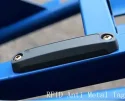Using RFID electronic tags to enhance the efficiency and accuracy of laundry services
2023-10-12
An RFID (Radio Frequency Identification) laundry tag is a small electronic tag that is designed to be attached or embedded into textile items such as clothing, linens, or uniforms. It utilizes RFID technology to track and manage the movement and usage of these items within a laundry or textile management system.
The main advantage of RFID laundry tags is their ability to automate and streamline laundry operations, providing numerous benefits such as:
Efficient tracking: RFID tags enable automatic and accurate identification of individual items without requiring a direct line of sight. This allows for fast and efficient tracking of items throughout the laundry process, from collection to washing, drying, folding, and delivery.

Improved inventory management: RFID tags provide real-time visibility into inventory levels, allowing laundry facilities to monitor the availability and location of items. This helps prevent stockouts, optimize inventory levels, and reduce the need for manual inventory counting.
Reduced loss and theft: By continuously monitoring the movement of tagged items, RFID technology helps minimize the occurrence of lost or stolen items. It enables quick identification of discrepancies between the expected and actual quantities of items, making it easier to identify and address potential issues promptly.
Enhanced operational efficiency: RFID laundry tags enable automation of various processes, eliminating the need for manual data entry and reducing human error. This leads to improved operational efficiency, faster turnaround times, and increased productivity within the laundry facility.
Cost savings: The automation and accuracy provided by RFID technology can lead to significant cost savings in labor, inventory management, and loss prevention. By optimizing processes and reducing human intervention, laundry facilities can operate more efficiently and reduce operational costs.

Durability: RFID laundry tags are designed to withstand the harsh conditions of laundering, including exposure to water, heat, chemicals, and physical stress. They are typically built to be durable and can withstand repeated washings and drying cycles, ensuring their longevity and reliability.
How RFID laundry tags have improved operational efficiency in laundry operations?
First,RFID laundry tags enable automated sorting of items based on predefined criteria such as color, size, or customer preferences. As the tagged items pass through RFID readers or portals, the system can quickly identify and sort them accordingly, eliminating the need for manual sorting and saving time.
Second,RFID tags provide real-time visibility into inventory levels. Laundry facilities can use RFID readers to conduct quick and accurate inventory counts, allowing them to identify shortages or excesses promptly. This eliminates the need for manual counting, which can be time-consuming and prone to errors.

Three,RFID laundry tags facilitate the tracking of items through each stage of the laundry process. By using RFID readers and software systems, laundry managers can monitor the movement of items, identify bottlenecks or delays, and optimize workflow accordingly. This helps ensure a smooth and efficient production process.
The most importance locating specific items within a large laundry facility can be time-consuming and labor-intensive. RFID technology enables quick and precise item location tracking. Laundry staff can use handheld or fixed RFID readers to locate items in real-time, significantly reducing the time spent searching for misplaced or lost items.
RFID tags enable efficient tracking of items during the distribution and delivery process. By scanning tagged items at various checkpoints, such as loading docks or delivery vehicles, laundry facilities can ensure accurate and timely deliveries. This reduces errors, eliminates manual paperwork, and improves customer satisfaction.
RFID cards technology: Challenges and precautions for rewriting and cloning
Categories
Title with button
this is a new beginning
We provide all your needed for starting your own online business, and even easier. Establish an online store, Oceans of Products Supply, Integrate Logistics Solution & Comprehensive After-sale Services.




